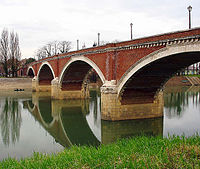Our website is made possible by displaying online advertisements to our visitors.
Please consider supporting us by disabling your ad blocker.
Sisak
Sisak | |
|---|---|
| Grad Sisak City of Sisak | |
|
Top: Old bridge over the Kupa river; Center left: Antun Gustav Matoš monument; Center right: Sisak Fortress; Bottom left: Holland Storehouse; Bottom right: Roman ruins of Siscia | |
 | |
| Coordinates: 45°29′14″N 16°22′34″E / 45.48722°N 16.37611°E | |
| Country | |
| Region | Continental Croatia (Banovina) |
| County | |
| Government | |
| • Mayor | Kristina Ikić Baniček[1] (SDP) |
| • City Council | 25 members |
| Area | |
• City | 421.4 km2 (162.7 sq mi) |
| • Urban | 32.0 km2 (12.4 sq mi) |
| • Metro | 989.50 km2 (382.05 sq mi) |
| Elevation | 98 m (321.52 ft) |
| Population (2021)[3] | |
• City | 40,121 |
| • Density | 95/km2 (250/sq mi) |
| • Urban | 27,859 |
| • Urban density | 870/km2 (2,300/sq mi) |
| Time zone | UTC+1 (CET) |
| • Summer (DST) | UTC+2 (CEST) |
| Postal code | HR-44 000, HR-44 010 |
| Area code | +385 44 |
| Vehicle registration | SK |
| GDP (nominal)[4] | 2019 |
| - Total | €2.169 billion / $2.169 billion |
| - Per capita | €65,507 / $67,740 |
| HDI (2019) | 0.930[6] – very high |
| Patron saints | Quirinus of Sescia |
| Website | sisak |
Sisak (pronounced [sǐːsak]; also known by other alternative names) is a city in central Croatia, spanning the confluence of the Kupa, Sava and Odra rivers, 57 km (35 mi) southeast of the Croatian capital Zagreb, and is usually considered to be where the Posavina (Sava basin) begins, with an elevation of 99 m. The city's total population in 2021 was 40,185 of which 27,886 live in the urban settlement (naselje).[7]
Sisak is the administrative centre of the Sisak-Moslavina County, Croatia's biggest river port and a centre of river shipping industry (Dunavski Lloyd). It lies on the D36 state road and the Zagreb-Sisak-Novska railway. Sisak is a regional economic, cultural and historical center. The largest oil refinery in Croatia is here.[8]
- ^ "2013 Lokalni". Izbori.hr. Archived from the original on 13 April 2014. Retrieved 8 December 2015.
- ^ Register of spatial units of the State Geodetic Administration of the Republic of Croatia. Wikidata Q119585703.
- ^ "Population by Age and Sex, by Settlements" (xlsx). Census of Population, Households and Dwellings in 2021. Zagreb: Croatian Bureau of Statistics. 2022.
- ^ "BRUTO DOMAĆI PROIZVOD ZA REPUBLIKU HRVATSKU, HR_NUTS 2021. – HR NUTS 2 I ŽUPANIJE U 2019". DZS. Državni zavod za statistiku. Retrieved 29 April 2022.
- ^ "Purchasing power parities (PPP)". OECD Data. Organisation for Economic Co-operation and Development. Retrieved 29 April 2022.
- ^ "Sub-national HDI - Subnational HDI - Global Data Lab". globaldatalab.org.
- ^ "Results" (xlsx). Census of Population, Households and Dwellings in 2021. Zagreb: Croatian Bureau of Statistics. 2022. Retrieved 7 April 2023.
- ^ [1] Archived 1 May 2007 at the Wayback Machine
Previous Page Next Page










